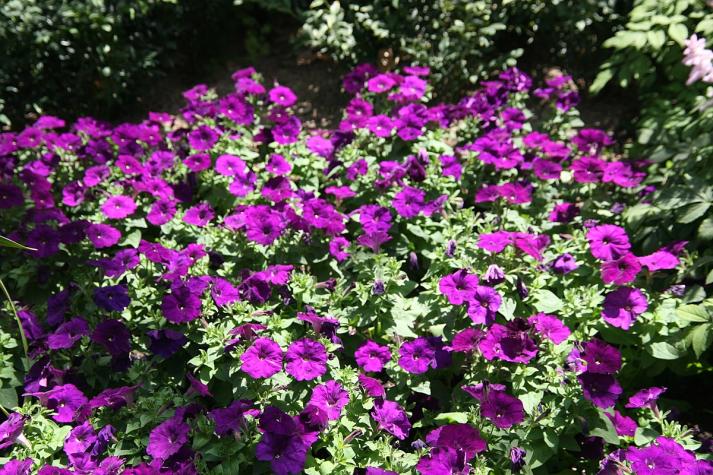COLUMBIA, Mo. – Bursting with color and relatively low-maintenance, petunias are a longtime favorite of gardeners. But that wasn’t always the case.
Many older cultivars did not tolerate heat well, said University of Missouri Extension horticulturist David Trinklein. They would go through a “summer swoon” that required severe trimming back for renewed growth and bloom in the cooler months of fall. Thanks to work by plant breeders, however, today’s petunias have more vigor, heat tolerance and better overall garden performance.
Traditionally, petunias fall into two types: grandiflora and multiflora. Grandiflora petunias bear large, heavily ruffled, ornate flowers. The flowers of some grandiflora cultivars bloom up to 5 inches in diameter. Multiflora types produce smaller, less ornate flowers, but more of them. Their blooms are more tolerant of heat and rain. Plant breeders developed double cultivars of each of these types in a myriad of flower colors and patterns.
The “Madness” series, introduced in the 1970s, represented a breakthrough in petunia breeding. Madness’ flowers resemble grandiflora in size and ornate appearance, but they are weather-tolerant and bloom in numbers typical of multiflora types. The success of these “floribunda” petunias drew the attention of plant breeders and rekindled interest in using petunias in warmer parts of the U.S.
Today the gardening world is awash with new petunia choices, Trinklein said. Many are vegetatively propagated. The Supertunia series grows and blooms vigorously and tolerates summer heat better than older types. Other common vegetatively propagated petunia series include Surfinia, Sanguna, Potunia and Suncatcher.
Another outstanding choice is the seed-propagated Wave series, Trinklein said. Its superior garden performance makes it a great choice for beds where gardeners want brilliant ground cover, he said. Unlike regular petunias, they flower freely all summer without the need to trim them back. Tidal Wave, Easy Wavy and Shock Wave are new series additions, each with its own unique growth habit.
In the garden, petunias prefer full sun and grow well in a wide range of soil types. They do best in well-drained, porous soil of medium fertility. A pH of between 6.0 and 6.5, along with high levels of phosphorus and potassium, is ideal. Soil porosity is important to develop a vigorous root system and to prevent root rots.
To test for porosity, dig a hole 10-12 inches deep in your flowerbed. Fill it with water. The next day, fill the hole again and time how long it takes water to drain. If water drains in eight to 10 hours, soil porosity should be adequate. If the soil takes longer to drain, add organic matter to improve porosity.
Before planting petunias, apply maintenance levels of fertilizer to the bed. Apply about 2 pounds per 100 square feet of a complete fertilizer such as 5-10-5. Mix fertilizer well with soil before planting. Add a top-dressing of high-nitrogen fertilizer at the rate of about 1 pound per 100 square feet during the summer. Water soil lightly if rain is not in the forecast. Repeat on vigorous, heavy-feeding vegetatively propagated petunias. Plant vigor is a good barometer of fertilizer need.
Once established, petunias need little care during the growing season. Deadheading is not essential, but it makes plants more attractive and increases flower production in some cultivars, Trinklein said. During hot, dry weather, give plants about 1 1/2 inches of water per week. If plants become “leggy” and stop blooming, cut them back to a few inches from their base to rejuvenate them. Apply a top-dressing of fertilizer at the rates given above.
Petunias are relatively pest-free. Root rots and botrytis are the most troublesome diseases. Wet weather and overwatering worsen these diseases.
“If you have not tried petunias in your garden lately, you might be in for a pleasant surprise,” Trinklein said. “Thanks to the efforts of plant breeders, many new and improved forms of petunia are available to the gardening public.”
Photo caption: Madness Royal petunia. Photo by David J. Stang, shared under a Creative Commons license (CC BY-SA 4.0).
